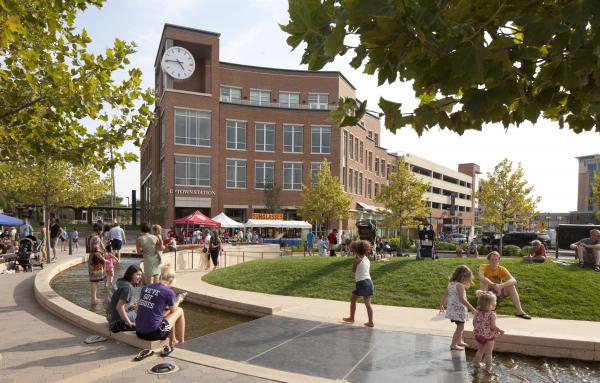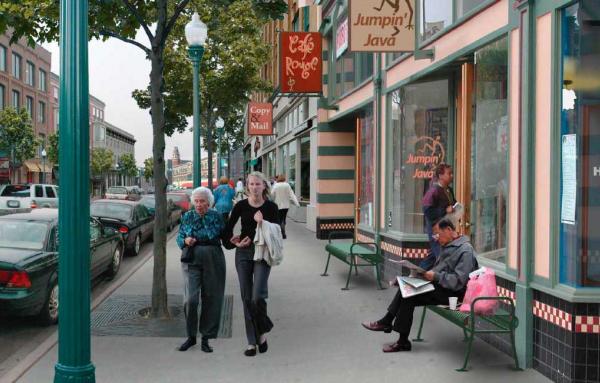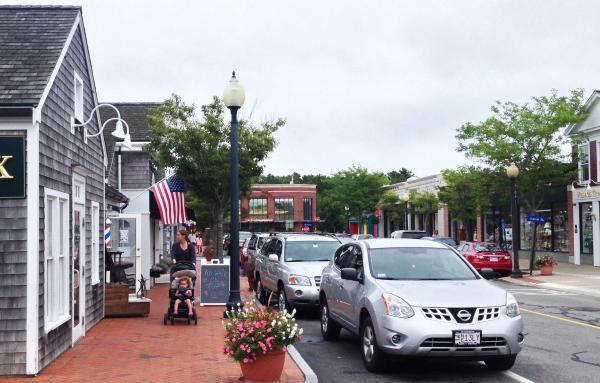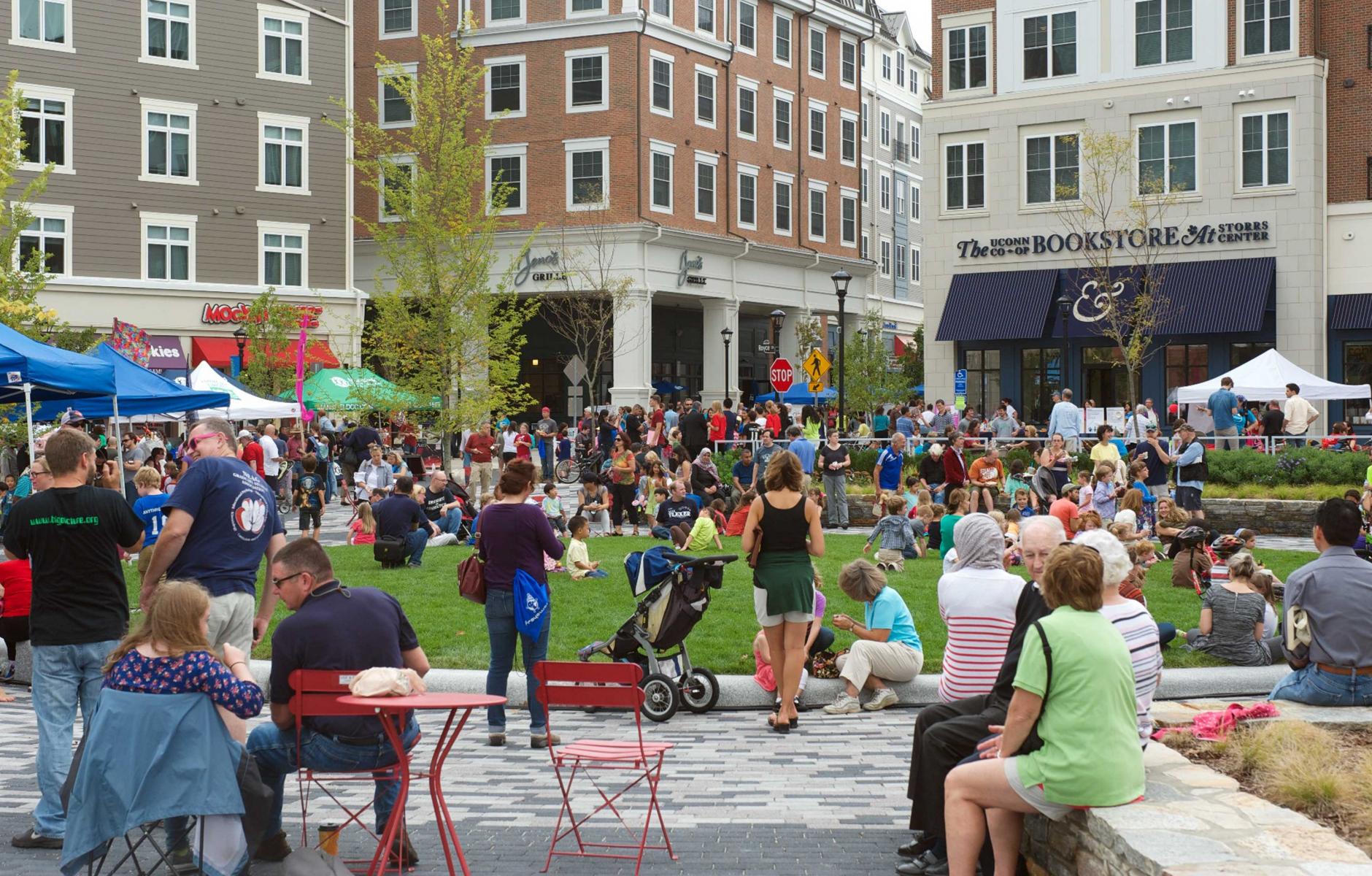
Great idea: Mixed-use urban centers
In celebration of the upcoming CNU 25.Seattle, Public Square is running the series 25 Great Ideas of the New Urbanism. These ideas have been shaped by new urbanists and continue to influence cities, towns, and suburbs. The series is meant to inspire and challenge those working toward complete communities in the next quarter century.
In the 20th Century, retail shifted from main streets and downtowns to strip shopping centers, enclosed malls, and big box stores. Building and revitalizing urban centers is one of the great tasks of the New Urbanism, including figuring out how traditional commercial centers function and incorporating mainstream retail into walkable places. The demands of retailers shape new urbanist designs for mixed-use urban and town centers, even as retail itself moves from brick-and-mortar stores to online sales.
Public Square editor Robert Steuteville interviewed planner and landscape architect Robert Gibbs, author of Principles of Urban Retail Planning and Development, and architect and urban designer Seth Harry, expert on sustainable commerce, on the challenges of mixed-use urban centers.
Can you talk about how retail has impacted New Urbanism and vice versa?
Gibbs: Retail has helped many New Urban communities sell houses at a at a higher rate and has helped to create more complete neighborhoods. New Urbanism has awakened developers to new ways of planning and developing retail that they wouldn't have considered before.
Harry: Retail has been important to New Urbanism from the very beginning because it resonated with that idea of compact, walkable, mixed-use. But having said that, it's a lot easier to talk about retail than to implement it in a practical matter. With respect to the fundamentals of viable retail, New Urbanism has experienced a steep learning curve, but also has generated some of the alternative strategies for pursuing it, especially when compared to generic, formulaic models that suburbia had generated. New Urbanism has started to inform more mainstream development, both retail and the concept of placemaking in general. We're starting to see a greater integration of retail and placemaking, at the level of conventional suburban infill projects and the types of projects that are traditionally associated with New Urbanism.
In term of locating and creating a successful town center, has the necessity for retail changed the strategies of New Urbanists?
Harry: Context drives so much in retail. You can't take an idea and arbitrarily deploy it without regard to that larger competitive context. And so some of the early examples of retail in New Urbanist projects suffered as a consequence. With the help of people like Bob and myself, new owners have become more sophisticated in terms of understanding how to integrate retail in a more practical way. At the same time, they recognize that the primary objective is still to create walkable places. As a result, we're seeing much more mature and sophisticated attempts at placemaking that coincides with a more pragmatic approach toward retail.
Gibbs: A lot of New Urbanist planners and developers have had to alter their desires and accept compromises, even from the beginning with the Kentlands (in Gaithersburg, MD). The first retail component for the Kentlands was effectively a community shopping center with large parking lots and large big-box retail. Some of the more enlightened developers like those at the Kentlands planned in such a way that it could be retrofitted eventually into a walkable block system. That's happening right now with the Kentlands on their former Kmart site. There have been a number of new urban plans that were a little too idealistic and often the retail wasn't implemented at all, or when it was implemented, it was an abysmal failure, with very low rents, or high vacancies, or high turnovers.
So there must be a happy medium in there somewhere.
Harry: On the other hand, I think a lot of well-intentioned new urban planners were talked out of doing better plans than they could have by brokers or inexperienced developers. They were primarily geared to build residential and were afraid to push back.
I was looking at some of the studies done by Christopher Leinberger on commercial development. I don't know if you've seen these. But of all the commercial development types, retail seems to be the most resistant to adapting to walkable places. In most metro areas, new multi-family and office development has shifted to walkable urban much more quickly than retail. Do you have any insights as to why that is?
Harry: I wouldn’t necessarily agree with that. There's walkable urban retail all over this country. It’s mostly in urban places. I lived for 10 years on Capitol Hill, which provides a great example of small scale, walkable, urban retail. My office is located in downtown Frederick, Maryland, a thriving main street community. The challenge occurs when you try to create urban fabric at a very small incremented scale, relative to the larger market context. The market context needs to be taken into consideration. Bob's example of the Kentlands is great, because that project belonged to a suburban market context when it was built, but it was planned and designed in anticipation of future densification and urbanization as the market context changes. You need to anticipate and plan for that long-term adaptation to the changing market context.
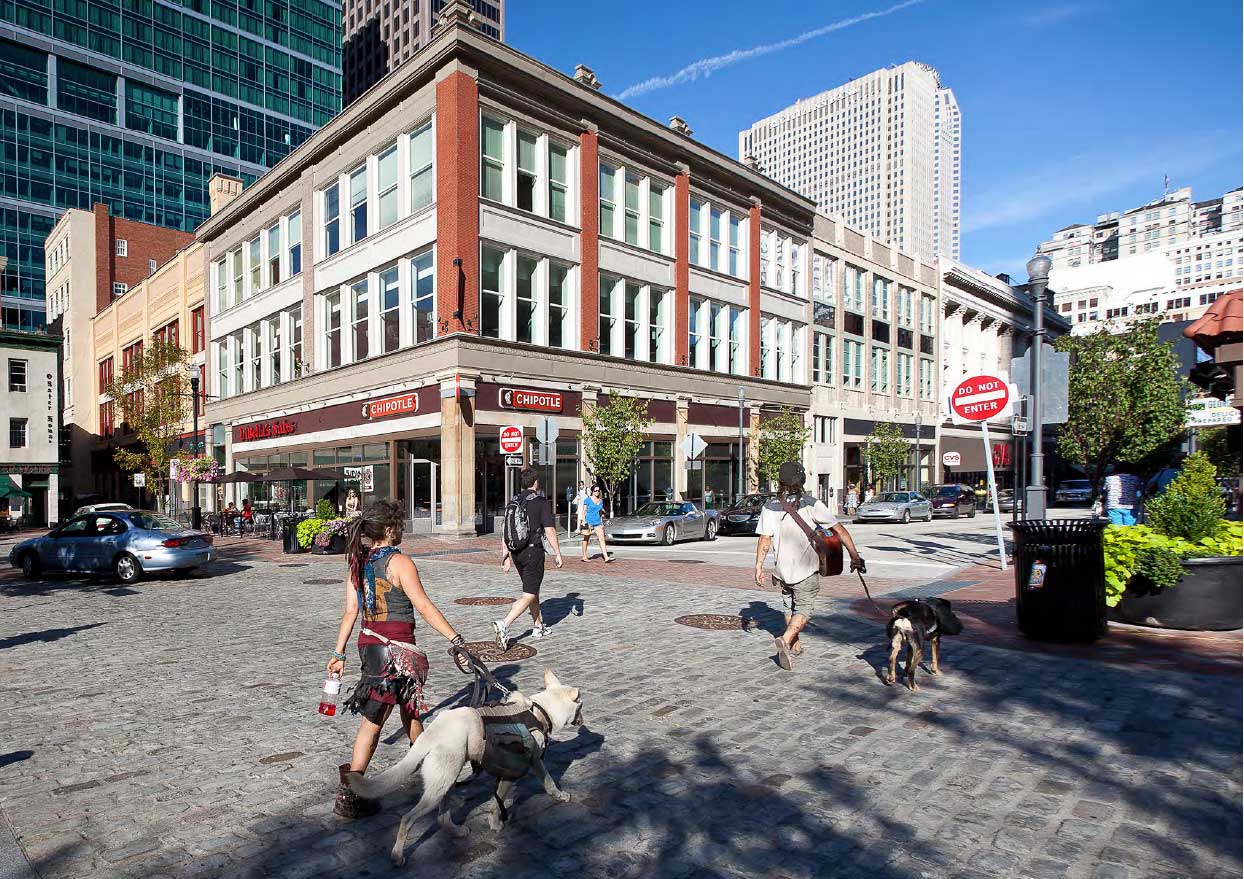
Gibbs: I agree with Chris [Leinberger], though, for the post-war new urban communities. They have, generally, been built in a conventional manner, but their retail hasn’t been nearly as resilient as their residential. I think that's more of a function of the shopping center typology. It's a fact that when people go grocery shopping and buy fifty or a hundred pounds of groceries, they can’t carry them a block-and-a-half to get to their car. When people go to a convenience store to buy a quick gallon of milk, the parking has to be convenient. They aren't going to walk a half-a-block or more to get in and out of a corner store. It's easy for the lifestyle/town center concept to build walkable formats. But those centers have a critical mass of 150,000 or 200,000 square feet of retail with heavy, strong anchors and people are going to spend an hour or longer shopping there.
Do you have to get to a point where people change their habits then, that they're not going to go necessarily shopping once a week, but they might start going a few times a week to the corner store or to walk around the corner to the pharmacy?
Gibbs: It's pretty hard to reeducate 300 million people how to do their grocery shopping.
Harry: Again, you have to put it in a context. Walkable retail works in urban places. It's the entire physical and competitive context that determines a lot of those factors. There are grocery stores in the greater DC metro area, for instance, that based on consumer market and land valuations can have underground parking. When you're trying to do an urban feel and functionality in a more auto-centric, suburban context, you have to take those factors into consideration when planning and designing the center. But you also need to think about the consumer behavior of potential shoppers. You have to be realistic about the market context.
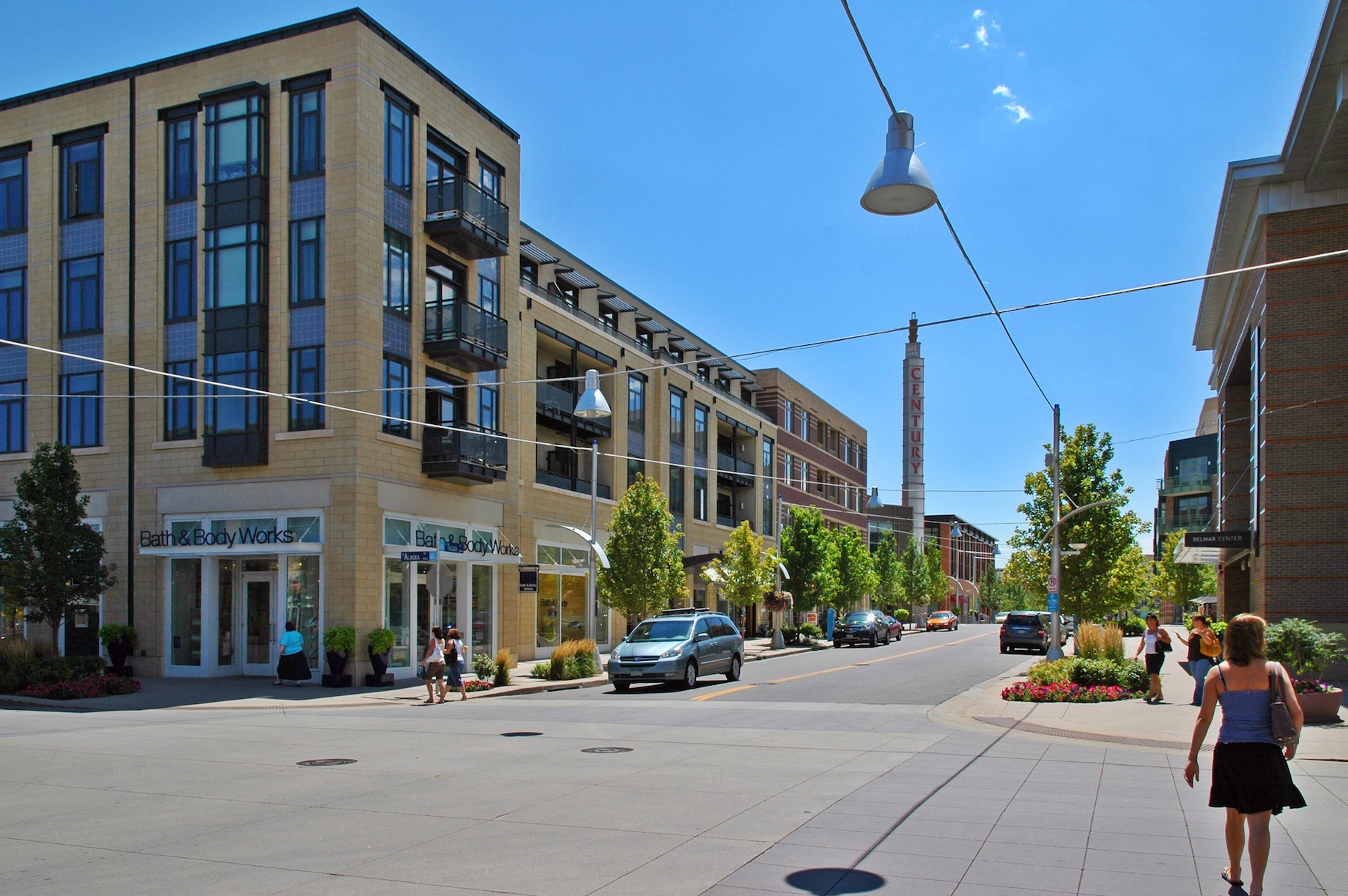
Gibbs: The hybrids, where people build partially walkable and partially conventional, don’t work because it ends up being neither. But when you have to build in a more conventional format, it’s best to plan the conventional center to be retrofitted into a walkable main street center as the property values and densities increase. Build the streets and the parking lots to set up the block system. Some of the New Urbanists have done that very well. They're turning over after 20 or 25 years.
But you really have to have a long-term vision beyond that seven-year time frame when a lot of developers are going to be out of their project.
Gibbs: I always ask my developers why they're building the New Urban retail center. I give them three choices. They're building it as a pure profit center, in which case, it tends to be more conventional. Or they’re building it as a legacy and they're not really concerned whether it breaks even or makes a profit, they just want to build a beautiful place. Or they’re building it as an amenity—to sell houses quickly. If they're building it as a legacy or an amenity, it can be a lot more flexible because it doesn’t require market rate rents for the retail. A lot of developers are building really beautiful twenty to forty thousand square-foot centers as an amenity. They're two- and three-story buildings right on the street with parking in the rear and they're really quite beautiful. The developer subsidizes the rents, because they're using them as an amenity to sell houses or build a legacy. Developers that want to build a profit center to get a market rate of return generally have to be more conventional except in the case of the larger town center format. Then there's a lot of flexibility. You can actually build the small blocks and put the parking in the back or underground or in structures.
What about if you're going for multiple markets. For instance you want to build multi-family in that town center as well as office buildings that are going to appeal to people who want an urban walkable place for their business. Does it then justify spending more on the retail?
Harry: The consumer market is what it is, and you have a couple of different ways of accessing that. In a lower-density suburban market context, it's accessed through the surface street network and by automobiles. If you're building a mixed-use- relatively dense, compact mixed-use center- then you have access to different consumers at different times of day that allows you to potentially build to either a higher quality or a larger center than you might otherwise be able to support based on a purely residential consumer market. All of those factors have to be taken into consideration. But it is possible that a town center can function as both an amenity and as a profit center.
In a conventional shopping center, there's nothing but retail, whereas in an urban town center or a main street or a downtown, there’s office, residential, and retail. You have lots of different things that you can sell.
Harry: Right, but the proximate consumer market even in those conditions is relatively incidental. You have to really look at the overall trade area and where your customer base is coming from. You start out with certain general formulas and then you modify them based on the specifics of a particular site or market.
Gibbs: It makes sense to build the mixed-use communities, especially three- to five-story buildings on top of the retail because you're already building the roof. You're already using the land. You're already building the footing. You're already building some parking. For not much more, you can build additional stories and then have the advantage of apartments or offices on top of retail, which makes the residential much more valuable. There's something called the Whole Foods effect, where if your apartments are within a five-minute walk of a Whole Foods, they rent for 12 to 18 percent more. It's just silly to build a Whole Foods and not develop residential nearby or to build nice restaurants and Starbucks without creating office or residential space nearby. That’s just leaving a lot of money on the table. But each of those land uses has to stand alone and give a return. You can't build retail and think that the residential will subsidize the cost of the retail. It's really foolish, right now in this economy, to build only retail without building adjacent land uses.
What are the major trends in town and urban centers today? If you could talk about how things have changed. You guys have been designing town and urban centers for 20 or 30 years. What's different today?
Harry: In the DC metro area, the post-recovery market has reached a fundamentally different threshold. Transit has been a huge factor in that, both in terms of land valuation and the type of development that has been occurring in proximity to those transit stations. In general the market is much more open and receptive to the benefits of building mixed-use. And then also consumer behavior and expectations have also changed. A lot of younger buyers actually appreciate and value the difference in the physical and social environment around mixed-use and they'll put a premium on that in terms of where they choose to live and work.
Gibbs: In the last 25 years, there's been a very wide and broad acceptance of the new urban planning principles and the Charter, including by most real estate developers. The theories of the New Urbanism have been broadly accepted as a way to get the highest return on your investment while still creating sound urbanism.
Can you talk a little bit about the suburbs versus the city and how the approach to walkable, urban, mixed-use in retail might differ between these two?
Harry: In the larger metro areas, the close-in suburbs are rapidly redeveloping based on New Urbanist principles. This has created a more urban approach in general to development. You have to place yourself along that continuum and plan for the current market realities, while at the same time also anticipate how those might evolve over time. Urbanism by definition tends to be more flexible and accommodating toward incremental change over time, whereas suburbia is not. And so by anticipating market changes and designing based on more urban principles, you actually do a better job of protecting the long-term value of that core asset. This in turn helps shape the nature of the future developments around it.
Gibbs: There's been a role reversal in that cities now are becoming more valuable and producing higher yields than the suburbs. Soon, the strong retailers will be leaving the malls and going into downtowns and going into cities. In the case of Detroit, the city’s downtown now has higher rents than the suburb of Birmingham, which formerly had the highest rents in the region. Downtown Detroit has a lower office vacancy than the suburbs. I think we're in the very early stages of this trend. The suburbs that are performing well are those that emulate cities and create mixed-use, walkable places. In my opinion the suburbs have peaked and I think they’re in the beginning of a long and deep decline.
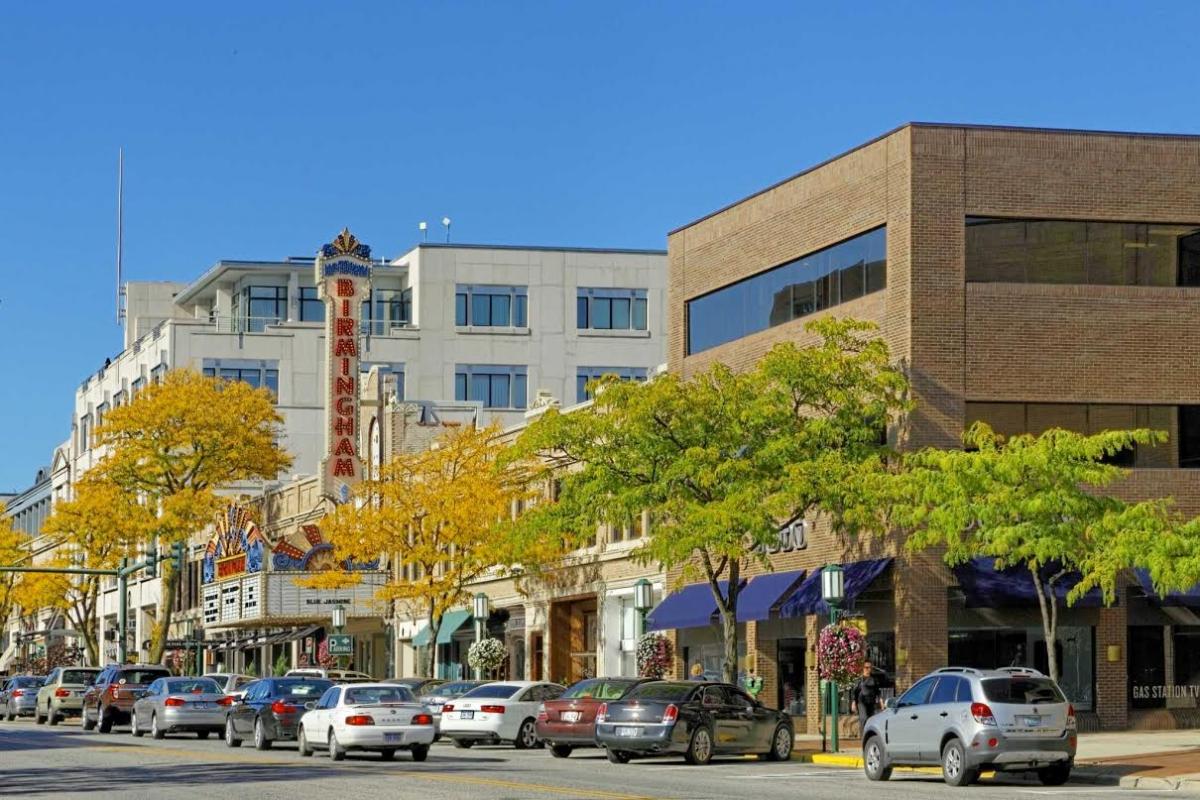
Harry: Or, as the case may be, they are redeveloping with more urban forms. This trend has had a huge impact on evaluations. So if you can't afford to live in DC the next best thing is to live in one of these new mixed-use town centers that have developed around the periphery, ideally adjacent to a metro stop.
Gibbs: Yeah, live in Rockville. Nobody can afford to live in the cities because too many people are living there.
That’s like the Yogi Berra quote, nobody goes there anymore because it's too crowded. The other advantage that you have in the city is you don't have to create the urbanism from scratch. It's already there. You're building upon a legacy that's 100 or 150 years old. In the suburbs, you often have to do a lot more placemaking. Why should retailers create urbanism in the suburbs as opposed to just moving into the city?
Harry: Don’t forget, there's still a lot of people living in the suburbs. Now, instead of an either/or proposition, we’re starting to see the suburbs become much more urban, both in character and in function. When you marry that to regional transit systems, you begin to make a polycentric urbanized area based on legitimate urban centers. It’s a transition in terms of how we think about urban centers as discreet, individual physical entities and how regions function. In many respects, the Charter is finally being realized at a scale where we start to get meaningful returns on the long-term investment that we've made collectively in this urban enterprise. We have reached a tipping point, both in terms of consumer preference and institutional preference for mixed-use. We’re starting to knit the region back together again as a network of urban places.
Beyond the urbanism trend, the retail industry is changing fast. We’re seeing the impact of online sales. Lots of physical stores are closing. How is this affecting the main streets, the downtowns, the walkable urban centers?
Gibbs: For better, the mall formula has now collapsed. The retailers that can support themselves are leaving the malls and going into downtowns. Internet sales often help the small independent retailers compete with the national chains. One independent shoe store with a good website can have the same sales as a strong national shoe store because they can have an international market for not a lot of money.
Harry: Internet sales have really gone a long way towards leveling the playing field between the smaller independent and mainstream retailers because it gives them access to the same consumer market that were formerly exclusive to the malls.
Gibbs: Still, the internet only accounts for 9% of gross retail sales, most of it in books and electronics. On the Internet, you're a buyer, you're not a shopper. You don't have any social experience. Downtowns offer a shopping experience instead of a buying experience. They offer social activities and experiential events that you can't get on the Internet and that you don't get in a mall.
How are the changing demographics affecting mixed-use centers?
Harry: This comes back again to the idea of real shopping and social interaction. Millennials are very socially driven in terms of shared experiences and in that regard, the demographics have been helping to drive consumer preferences for urban places as well as transportation choice.
Can both of you give me some examples of innovative town centers or urban centers that you've seen recently?
Harry: In places like Columbia, Maryland, which were the last of the previous generation of planned communities, the area around the mall is currently being redeveloped as a walkable downtown. That's something that would have been almost unimaginable a generation ago.
Gibbs: The latest new town center is Avalon in Alpharetta, Georgia. It combines a Whole Foods and cinema with residential, office hotel space. There's another new development outside of Cincinnati, Ohio, called Liberty Center .It also has a healthy dose of residential, office and hotels. The new thing is not to build one land use but to build four.
Harry: The area that has a lot of personal interest for me is the smaller, neighborhood scale redevelopment that often happens along major suburban arterials. Again, a lot of these older, immediate post-war suburban commercial nodes are now redeveloping as mixed-use neighborhoods. That's an exciting new development because now we're starting to flesh out the full spectrum of community types, not just in the regional level, but we're starting to see it work it's way down to the community center scale and the neighborhood center scale.
Gibbs. That's the real opportunity, to go to that smaller scale where you can perform an easy infill on a 5 or 10-acre parcel.
Harry: A metro area of any size is going to have dozens and dozens of these smaller scale opportunities, and I think that's where you're going to start to see a lot of real innovation, where you have local entrepreneurs going in and making these opportunities happen.
Gibbs: We're entering a new era now because there's a whole toolkit for developers that has been tried and tested: the mixed uses, the critical buildings, the smaller parking lots, the street. We now know this sort of urbanism works. Developers are learning how to create this and there's lots of sites that are becoming available.
As we're seeing so many department stores closing and malls struggling, it must be making municipalities nervous because that's a source or major tax revenue. Should they be worried or should they be viewing this as an opportunity?
Harry: It's an opportunity to keep a lot more money in the community because it's the consumer demand that's driving the shopping, not the other way around. We’re witnessing a deconstruction or a reversing of the process of consolidation. Take beer, for example. We went from a nation of nothing but craft breweries to two or three national brewers and now we’re back to where we started. We’re seeing the same thing happen at the retail end of the spectrum. In particular it's an opportunity because it refocuses on local and regional economies and investment.
Gibbs: But a lot of the communities that are losing their malls and shopping centers should be concerned because even though it's technically possible to redevelop these into dense, walkable places, it's political suicide. There are a lot of communities with dying malls that approach us and they tell us that they only want five or eight houses per acre with large parking densities. They're still thinking in that suburban way of redeveloping new centers. It's frustrating because a lot of these old centers are going to be developed as another hybrid version of a suburban mall. Technically, there's the opportunity. And it’s there in the market demand. But politically, most communities that we work in aren't ready to embrace the densities and the design standards that are necessary to accomplish this.
Do you have any advice for a developer or a municipality that wants to build a village or town center as part of a new neighborhood? What are the most important things for them to do?
Gibbs: It's essential that they know what the market realities are and what is possible, particularly the feasible residential and shopping center typologies. A lot of cities plan things that are not based in any kind of reality. They base everything on parking structures and underground parking. They're based on rents that are completely unachievable.
Harry: On the other side of that, they need to be flexible and think long term. They need to have a strategy for getting from where they are today to where they ultimately want to be. If you plan thoughtfully and strategically, you can do that incrementally over time, be successful, and make money.
Note: CNU intern Benjamin Crowther helped to produce this interview and article.





